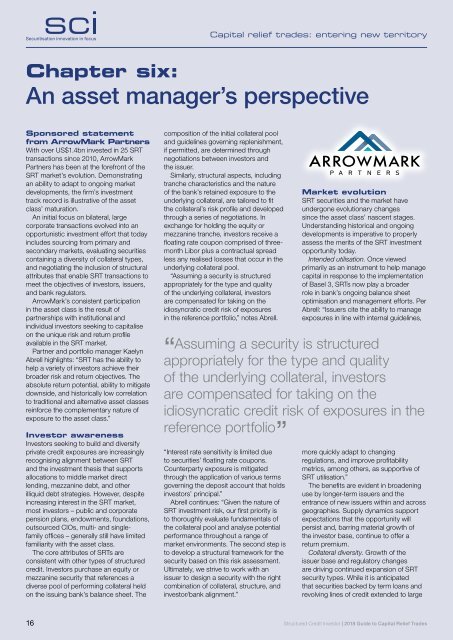SCI Regulatory CapitalRelief Research Report
Create successful ePaper yourself
Turn your PDF publications into a flip-book with our unique Google optimized e-Paper software.
Securitisation innovation in focus<br />
Capital relief trades: entering new territory<br />
Chapter six:<br />
An asset manager’s perspective<br />
Sponsored statement<br />
from ArrowMark Partners<br />
With over US$1.4bn invested in 25 SRT<br />
transactions since 2010, ArrowMark<br />
Partners has been at the forefront of the<br />
SRT market’s evolution. Demonstrating<br />
an ability to adapt to ongoing market<br />
developments, the firm’s investment<br />
track record is illustrative of the asset<br />
class’ maturation.<br />
An initial focus on bilateral, large<br />
corporate transactions evolved into an<br />
opportunistic investment effort that today<br />
includes sourcing from primary and<br />
secondary markets, evaluating securities<br />
containing a diversity of collateral types,<br />
and negotiating the inclusion of structural<br />
attributes that enable SRT transactions to<br />
meet the objectives of investors, issuers,<br />
and bank regulators.<br />
ArrowMark’s consistent participation<br />
in the asset class is the result of<br />
partnerships with institutional and<br />
individual investors seeking to capitalise<br />
on the unique risk and return profile<br />
available in the SRT market.<br />
Partner and portfolio manager Kaelyn<br />
Abrell highlights: “SRT has the ability to<br />
help a variety of investors achieve their<br />
broader risk and return objectives. The<br />
absolute return potential, ability to mitigate<br />
downside, and historically low correlation<br />
to traditional and alternative asset classes<br />
reinforce the complementary nature of<br />
exposure to the asset class.”<br />
Investor awareness<br />
Investors seeking to build and diversify<br />
private credit exposures are increasingly<br />
recognising alignment between SRT<br />
and the investment thesis that supports<br />
allocations to middle market direct<br />
lending, mezzanine debt, and other<br />
illiquid debt strategies. However, despite<br />
increasing interest in the SRT market,<br />
most investors – public and corporate<br />
pension plans, endowments, foundations,<br />
outsourced CIOs, multi- and singlefamily<br />
offices – generally still have limited<br />
familiarity with the asset class.<br />
The core attributes of SRTs are<br />
consistent with other types of structured<br />
credit. Investors purchase an equity or<br />
mezzanine security that references a<br />
diverse pool of performing collateral held<br />
on the issuing bank’s balance sheet. The<br />
composition of the initial collateral pool<br />
and guidelines governing replenishment,<br />
if permitted, are determined through<br />
negotiations between investors and<br />
the issuer.<br />
Similarly, structural aspects, including<br />
tranche characteristics and the nature<br />
of the bank’s retained exposure to the<br />
underlying collateral, are tailored to fit<br />
the collateral’s risk profile and developed<br />
through a series of negotiations. In<br />
exchange for holding the equity or<br />
mezzanine tranche, investors receive a<br />
floating rate coupon comprised of threemonth<br />
Libor plus a contractual spread<br />
less any realised losses that occur in the<br />
underlying collateral pool.<br />
“Assuming a security is structured<br />
appropriately for the type and quality<br />
of the underlying collateral, investors<br />
are compensated for taking on the<br />
idiosyncratic credit risk of exposures<br />
in the reference portfolio,” notes Abrell.<br />
“Interest rate sensitivity is limited due<br />
to securities’ floating rate coupons.<br />
Counterparty exposure is mitigated<br />
through the application of various terms<br />
governing the deposit account that holds<br />
investors’ principal.”<br />
Abrell continues: “Given the nature of<br />
SRT investment risk, our first priority is<br />
to thoroughly evaluate fundamentals of<br />
the collateral pool and analyse potential<br />
performance throughout a range of<br />
market environments. The second step is<br />
to develop a structural framework for the<br />
security based on this risk assessment.<br />
Ultimately, we strive to work with an<br />
issuer to design a security with the right<br />
combination of collateral, structure, and<br />
investor/bank alignment.”<br />
Market evolution<br />
SRT securities and the market have<br />
undergone evolutionary changes<br />
since the asset class’ nascent stages.<br />
Understanding historical and ongoing<br />
developments is imperative to properly<br />
assess the merits of the SRT investment<br />
opportunity today.<br />
Intended utilisation. Once viewed<br />
primarily as an instrument to help manage<br />
capital in response to the implementation<br />
of Basel 3, SRTs now play a broader<br />
role in bank’s ongoing balance sheet<br />
optimisation and management efforts. Per<br />
Abrell: “Issuers cite the ability to manage<br />
exposures in line with internal guidelines,<br />
“<br />
Assuming a security is structured<br />
appropriately for the type and quality<br />
of the underlying collateral, investors<br />
are compensated for taking on the<br />
idiosyncratic credit risk of exposures in the<br />
reference portfolio<br />
”<br />
more quickly adapt to changing<br />
regulations, and improve profitability<br />
metrics, among others, as supportive of<br />
SRT utilisation.”<br />
The benefits are evident in broadening<br />
use by longer-term issuers and the<br />
entrance of new issuers within and across<br />
geographies. Supply dynamics support<br />
expectations that the opportunity will<br />
persist and, barring material growth of<br />
the investor base, continue to offer a<br />
return premium.<br />
Collateral diversity. Growth of the<br />
issuer base and regulatory changes<br />
are driving continued expansion of SRT<br />
security types. While it is anticipated<br />
that securities backed by term loans and<br />
revolving lines of credit extended to large<br />
16<br />
Structured Credit Investor | 2018 Guide to Capital Relief Trades





